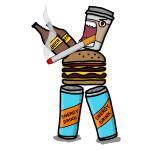How to Snack?
How can you keep snacking from derailing your healthy eating program, not to mention weight control? Try these tips.
Keep junk food out of the house.

There’s a lot of truth to the old joke about the “see-food diet” — you see food and you eat it. The opposite is also true. If you don’t have junk food lying around, the sight of it won’t tempt you, so don’t even bring it home. After all, you can’t eat what isn’t there. Or, if someone in your household tends to have chips or other unhealthful snacks, put them out of sight.
Don’t skip meals.
Skipping meals may seem like a good way to cut calories, but in fact this just makes you so hungry later in the day that you’re vulnerable to devouring mega-portions of snack food in order to supply your body with easily digested sugars.
Snack mindfully.

Have you ever watched a show on television with a bag of chips or pint of ice cream in hand, only to find that it was all gone before you knew it? This type of mindless eating can pack on a lot of unwanted calories. The solution is simple. Try not to snack while doing something else like surfing the Web, watching TV, or working at your desk. Instead, stop what you’re doing for a few minutes and pay attention to your snack. Savoring a piece of fine chocolate can be more satisfying than gobbling down a whole chocolate bar.
Remember, you can take it with you.

Think ahead and carry a small bag of healthful snacks in your purse or the glove compartment of your car. If you have a healthy snack handy — preferably, one you really like — you won’t turn in desperation to the calorie-laden cookies at the coffee counter or the candy.
Zero in on hunger.

Before you snack, ask yourself, “Am I truly hungry?” Many of us mistake emotions, such as stress and fatigue, for hunger. If the answer is yes (your stomach feels hollow, your head is achy), make sure you’re not confusing hunger with thirst. Drink an 8-ounce glass of water, then wait 10 to 15 minutes. If you’re still hungry, have a healthful snack.
Know your cravings.

If you want a snack, but you’re not hungry, attack cravings from a psychological level. Ask yourself how you’re feeling. Lonely? Bored? Stressed? Then, ask yourself the bigger question: Will food fix this problem? The answer is always no. Eating a cookie, for example, won’t address a problem at work that you’re worried about. Go for a walk around the block, do a few stretches, put on some music, or choose another simple activity that might distract you or boost your mood. Then if you still want the food, fine. Ask yourself what food you really want. Then eat only a small amount, and make it good. If you’re craving chocolate, for example, eat one small square and savor it. It’s important that you snack on what you’re craving rather than deny the craving. Eating around a craving may only cause you to eat more because the craving isn’t satisfied.



